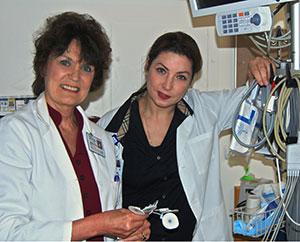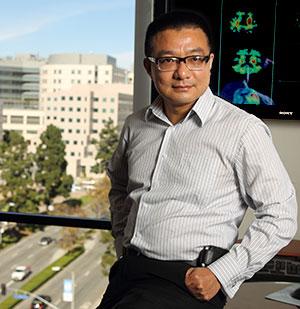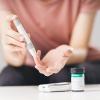
Battling Alarm Fatigue
Talk about the dangers of multitasking.
“You’re in sterile garb with a patient, and in the next room an alarm goes off. You have to decide if it’s a bed alarm, a ventilator alarm or something else – you need to memorize those sounds and most monitors have multiple sounds. You have to make a decision about whether it’s a technical problem or something more serious, and then you have to decide if and how quickly you need to respond,” says Barbara Drew, an internationally recognized cardiac monitoring expert who is a professor in the critical care/trauma program at UC San Francisco School of Nursing and in the Division of Cardiology at UC San Francisco School of Medicine.
The decision points she describes are disturbingly frequent, especially in intensive care units (ICUs), where nurses might hear over a hundred alarms an hour, many of them false positives. There is a lot at stake in these complex interactions among people, processes and technology that lead to what has come to be known as alarm fatigue: where clinicians turn down, turn off or tune out the alarms because they are exhausted by their frequency and the number of times they are false. Awareness of the dangers is rising fast around the country.
In one highly publicized case in Pennsylvania, the muting of an alarm cost a teen her life and the surgery center a $6 million malpractice settlement. According to a recent article in the Washington Post, over a three-and-a-half-year period ending June 2012, the Joint Commission had reports of 98 alarm-related incidents, including 80 deaths; in more than 60 percent of the cases, alarms were either inappropriately turned off or were not audible in all areas. The commission believes the reports, which are voluntary, do not begin to tell the whole story and has established a national patient safety goal on alarms that goes into effect in 2014 (see sidebar).
Along with colleagues at UCSF Medical Center and nursing schools that include Johns Hopkins and Yale, Drew is among a small group of nurse scientists conducting research to inform emerging regulations and processes and, ultimately, solve the problem. At the moment, her collaborative project with GE Healthcare is designed to characterize every piece of clinical information ICU alarms deliver so device manufacturers have the data they need to create better, smarter alarms.
She cautions, however, that the solutions go beyond better technology. “This is a multifactorial problem – technology, nursing practice and systems – and we have to approach it from all of those angles,” says Drew.
Understanding the Problems
In large part, alarm fatigue is an unintended consequence of industry engineers responding successfully to the increased acuity of hospitalized patients. Monitoring equipment has become remarkably proficient at conveying many different signs of a patient’s health, including heart rhythms, oxygen saturation, blood pressure and respiration. Partly out of a desire to keep patients safe and partly out of fears about liability, hospitals and manufacturers typically err on the side of capturing every potentially relevant piece of data and setting highly sensitive algorithms for the associated alarms.
“So now we’ve got situations where a heart rhythm monitor might have 40 different measurements and, in some cases, even if [one measurement] is over a threshold by one small point for a brief period, it sets off the alarm,” says Drew.
This can be particularly frustrating when an alarm that indicates a nurse should drop everything is only aping a critical diagnosis. Patients sweating or squirming, those with ventricular assist devices, or an electrode falling off can all mimic and trigger a false life-threatening alarm.
“Unfortunately, a majority of rhythm alarms are actually [false positives],” says Drew.
The false positives create a lot of unnecessary noise, both literally and figuratively. This puts nurses – who are usually the ones responsible for deciding on a response – in a difficult position. On the one hand, the same concerns about patient safety and potential liability that hospitals and manufacturers feel tend to have nurses erring on the safe side. Concerned patients and families, who can’t always know what the alarms mean, add to those pressures.
“But if the nurse responds to a false crisis 29 times in a half hour, the 30th time she may not move so fast,” says Drew.
“Also, ICUs are high-acuity patient care areas, with many skilled clinicians in a relatively compact and oftentimes noisy area, which can easily lead to people becoming desensitized or habituated to the sounds coming from physiological monitoring and/or therapeutic devices such as ventilators, enteral feeding pumps and infusion pumps,” says Tina Mammone, a director of clinical operations in the Department of Nursing at UCSF Medical Center, as well as one of Drew’s doctoral students.
Envisioning Solutions
There are numerous, often overlapping ideas for improving the technology: Alarms that adapt to individual patients’ specific vital signs, instead of an abstract norm. Algorithms that can integrate multiple signals from multiple monitors and then sound an alarm only when there is a true need for action. Alarms that are directed only at relevant clinicians.
But as noted earlier, Drew believes relying solely on technological change is not the answer. Hospital policy, an area in which the Joint Commission and patient safety research organizations like the ECRI Institute are particularly interested, is a second piece of the puzzle.
“We are working with hospitals and hospital systems to create clear guidelines about things like how to set alarm limits and when it’s appropriate to customize alarms for particular patients,” says ECRI’s James P. Keller, Jr., vice president of Health Technology Evaluation and Safety. “Hospitals need protocols by care area and specialty – and they need to give more thought to the nuances of technology, how the different devices, brands and models work.” Wherever possible, he says, standardizing equipment throughout a health system can simplify training and reduce risks.
Training connects to the third significant factor in alarm fatigue: nursing practice. “Device manufacturers have an obligation to make a good product, but as users, we have an obligation as well,” says Mammone.
Nursing Practice
 Barbara Drew (left) and Tina Mammone To help fulfill that obligation, Mammone is conducting a clinical study, funded by the American Association of Critical-Care Nurses, in two neuro ICUs at UCSF Medical Center. It tests whether a combination of adjusting certain alarm settings and changing clinical practice can reduce the physiologic monitor alarm burden.
Barbara Drew (left) and Tina Mammone To help fulfill that obligation, Mammone is conducting a clinical study, funded by the American Association of Critical-Care Nurses, in two neuro ICUs at UCSF Medical Center. It tests whether a combination of adjusting certain alarm settings and changing clinical practice can reduce the physiologic monitor alarm burden.
One piece of the study will test whether short alarm delays will give the “artifacts,” or brief physiological changes that generate “nuisance alarms,” enough time to correct themselves. “These types of delays are already in place in newer devices in a number of hospitals, but this is a good opportunity to see how much the delays reduce nuisance alarms and diminish alarm fatigue – and to evaluate patient outcomes associated with any changes,” she says.
The second part of the study focuses on the common problem of electrocardiogram (ECG) electrodes falling off or making poor contact with the skin, which can generate false-positive alarms for arrhythmia and some technical alarms. Sometimes, she says, an ECG lead falls off because of poor-quality electrodes related to insufficient conductive gel; other times they fall off because of inconsistencies in nursing practice around skin preparation, failure to change the electrodes regularly and even something as simple as the inappropriate storage of supplies, which causes the electrodes to dry up before use.
“When patients are placed on continuous physiological monitoring, we have [involved] procedures in place to prep the skin properly, but sometimes when clinicians are pressed for time, steps are skipped or abbreviated in the interest of quickly initiating monitoring, so the electrodes don’t conduct as well, or produce a lot more artifacts,” she says.
Her intervention supplies nurses with prepared kits that include ECG skin preparation paper, which has an abrasive fine sandpaper finish, as well as high-quality ECG electrodes in sealed foil packets that are resistant to moisture. Nurses will properly prepare the skin and change the electrodes every 24 hours to improve the quality of the ECG and other waveform signals.
For Mammone, the work exemplifies something nurses can do now to minimize the potential for alarm fatigue in the ICU setting. “We’re not engineers, but we play an important role in minimizing alarm fatigue and improving patient safety,” she says.
Gathering and Understanding the Data Generated
As for Drew’s collaboration with GE, since March 2013 her team has been comprehensively gathering data 24/7 from 77 beds across five ICUs at UCSF Medical Center. An initial look at the data found that the bedside monitors have generated 2.5 million alarms in one month – an average of 1,100 alarms per bed per day. Drew and her team are also carefully annotating the clinical data – identifying what information it provides and characterizing its clinical importance.
“Until now nobody has done this kind of systemwide storage of every single patient and alarm, nor have they looked at it with this kind of scrutiny,” she says.
“Building better algorithms depends on having good data,” says Jeffrey Conner of GE Healthcare. “Raw data is not enough, and this is where Barbara’s annotations will be so important.” He says the annotations will help his team more precisely characterize true and false alarms, as well as alarms that are more and less meaningful. To help make the annotations as relevant as possible, his team has been helping Drew’s team understand how the algorithms work today.
Where We Go Next
 Xiao Hu But all of the defining and refining is only one stage of a larger effort, says biomedical engineer Xiao Hu, who recently joined the faculty at UCSF School of Nursing after a stint in the Department of Neurosurgery at UCLA. He is among the first biomedical engineers in the country on faculty at a nursing school.
Xiao Hu But all of the defining and refining is only one stage of a larger effort, says biomedical engineer Xiao Hu, who recently joined the faculty at UCSF School of Nursing after a stint in the Department of Neurosurgery at UCLA. He is among the first biomedical engineers in the country on faculty at a nursing school.
Hu says by joining forces with Drew, he’s hoping they can ultimately create a truly “smart” monitoring system, one that integrates data from a variety of sources – all the monitors, a patient’s electronic medical record and, someday, molecular data as well – and contains algorithms that enable decision support that strikes the appropriate balance between sensitivity and specificity.
“One way to make the machines smarter is if instead of responding [with an alarm] to every single different measurement, they act more like a nurse or physician and fuse together different data points to understand what is clinically meaningful,” says Drew.
“The immediate challenge is getting all of the data integrated into one coherent form that can be analyzed,” Hu says. “We are getting close with this. There are mature commercial solutions – Barbara is using a great tool that takes care of data integration from the monitors – but many vendors still don’t talk to each other, and we need to solve that problem.”
A more difficult, long-term hurdle, he says, is creating the complex algorithms that can reliably make sense of all this data to activate alarms at just the right moment – and only that moment.
An expert in what is called machine learning, Hu says that the smart machines initially rely on human intelligence to interpret data and create clinically valid parameters for things like predicting cardiac arrest or recognizing dangerous intracranial pressures. “It’s essential that clinical experts like Barbara give the initial guidance to inform the algorithms,” he says.
But to respond to constantly changing inputs and individual biology, smart machines may also need to generate their own unique algorithms based on growing data stores that the system generates: human intelligence, says Hu, augmented by computer intelligence.
“My research tries to leverage these different machine-learning paradigms so we can create something new in the clinical domain,” he says. He notes, of course, that due to the risks involved, any new equipment will have to pass rigorous evaluations, both from peer scientific reviewers and from federal regulators – and that is as it should be.
In addition, Hu, Drew and Mammone all agree that another critical aspect of evaluating any emerging technology is its usability. “Too often usability testing is overlooked until something bad happens,” says Hu. “This team we are assembling has all the proper expertise to understand the concerns and do the proper clinical and usability testing.”
This may become especially important if due to worries about regulation, costs or liability, industry lacks the will to invest in creating the next generation of machines. Should the current cooperative spirit break down, says Drew, “We may have to make our own software and get it patented.”
All the effort will be worth it, she says, because while alarm fatigue is a deadly serious concern, it doesn’t negate the lifesaving value of these monitors. “I know people are beginning to wonder if the alarms are more trouble than they’re worth – and we do need to do better,” says Drew. “But there are plenty of times alarms have alerted us to something that was real, and we’re damn glad that they did.”



